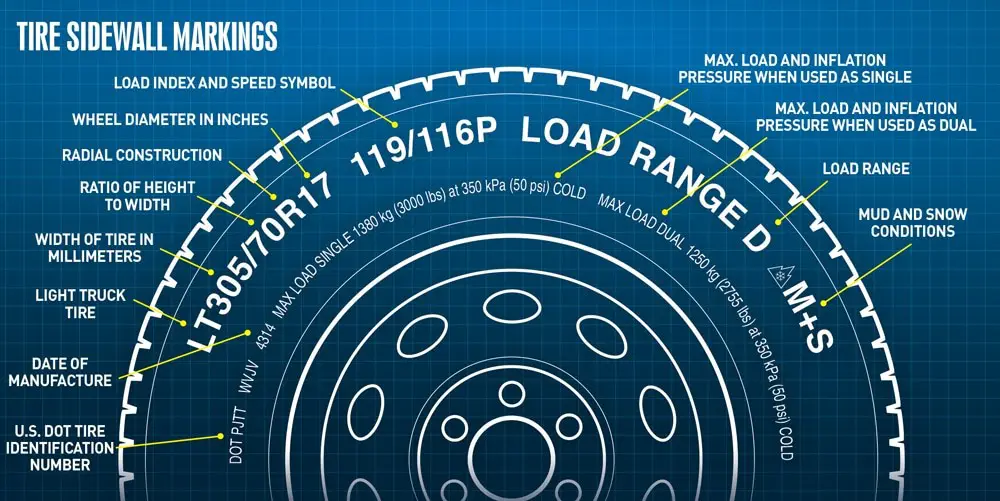Hey! This site is reader-supported and we earn commissions if you purchase products from retailers after clicking on a link from our site.
In this article we’re going to take a look at your RVs tires and whether or not they’re safe for you to use when you’re a full-time RVer or a part-time RVer. We’ll also look at what tire would work best for boondocking in rougher terrain and which tire is more suitable for strictly road use. But first, I’m also going to share some personal insight and my opinion as to why the RV manufacturing industry cuts quality on new RVs before they are sold to the consumer.
Quality products vs. the manufacturers profit margin
Let’s face it, RV manufacturers are in business to make a profit and that’s understandable because no one gets into any type of business to lose money. However, I draw the line when it comes to installing sub-par tires on a new RV to save a few dollars.
While these manufacturers are following the guidelines set forth by the U.S. Department of Transportation (DOT) regarding the minimal requirements for RV tires, quite often they are circumnavigating those guidelines by installing tires that are approved only for the weight of the RV at the time of purchase.
Manufacturers never consider the weight that the consumer will add to the RV after they purchase their rig. As a rule, most full-time RVers will add several hundred pounds of additional weight while they’re traveling. Items such as clothing, dishes, food and beverages, cleaning supplies and outdoor lawn furniture will add a lot of extra weight. Also, the RV manufacturers don’t factor the weight of a full freshwater tank, and the gray water or black water tanks when they factor the weight of your camper. In other words, RV manufacturers base the size and weight rating of your tires by the empty weight of your camper when it’s manufactured, and they don’t factor in the additional weight added by the average full or part time RVer.
Frankly, I would never purchase a new RV without first insisting that the dealer upgrade my tires to the next size higher with regards to my RVs weight. To do otherwise, would not be in your best interest as they could easily blow-out while driving down the road because it puts too much stress on the sidewalls of your tires.
With that said, I’ve met numerous fellow RVers over the years that have learned this lesson the hard way. In fact, one couple I met at a campground in Tennessee had owned their newly purchased 5th wheel camper less than a year and two of their four trailer tires failed within their first year of traveling.
The fact of the matter is this, RV manufacturers routinely install inadequate tires, shocks, and even whole suspension systems on their models because they’re looking at profitability. They don’t care about your safety; they care about their profit margin. To be honest with you, I don’t understand why there’s never been some class-action lawsuit that has addressed this issue previously.
Understanding what tire your RV needs and a look at your tire markings
Understanding your tires sidewall markings is a good place to start when upgrading to safer and more efficient tires for your RV.

In this graph, you’ll see what each marking represents as to its use when selecting a replacement tire or an upgraded tire for your RV. While the LT on this tire means “light truck” and is meant for a tow vehicle, for the most part, the same markings will apply to your trailer although it’s likely that the LT designation will be changed to ST which stands for “special trailer”.
With that said, you’ll find a series of smaller numerical and alpha characters located on the inside of your tire closest to the tire’s rim that are designated as DOT numbers. These characters will begin with DOT and they represent the model and specifications of the tire registered with the U.S. Department of Transportation that’s approved for use with this RV as well as what plant manufactured tire. The last four numbers of this marking are always a four-digit designation, and it represents the week and year of the tires manufacture. In this example, the number 4314 means that the tire was manufactured in the 43rd week of 2014. Quite often, these last four digits will have a single line raised circle or oval around them making them extremely easy to spot when you’re reviewing your tire specifications.
To me, this information is especially important to know when purchasing a used RV. I recommend that you understand the age of the RVs tires you are buying, and how they can fail over time if they’re not properly maintained.
How to understand and set the proper tire pressure
Staying on the subject of the inside tire markings, the next set of characters you’ll see, will show the amount of pressure per square inch (PSI) that the tire should be maintained at in various weather conditions including temperature variations and pressure changes due to changes in elevations. In the example in the graph above, you’ll see that the PSI for this tire in listed as 50 regardless of usage as a single tire or used a dual tire. It also doesn’t have a separate designation regarding elevation or air temperature. This is a good thing, but keep in mind that in this example, these are the specifications for the light truck tire used to tow the camper and not for the RV specifically. It’s highly likely that the numbers on your trailer tires will have different PSI ratings based upon factors such as usage, or weather conditions such as elevation or air temperature and in some cases, even road conditions. Understanding the PSI setting for your RV and its tow vehicle is critical. To not understand these requirements and not maintaining the recommended settings could lead to serious problems such as a tire blow-out or even an accident.
Read my full article on how to set the right tire pressure for your RV tires for more information on the topic and read Mike’s guides on the best tire pressure monitoring systems and the best RV air compressors.
Markings for sizing systems
Now we’ll examine the larger case alpha-numeric codes on the outside perimeter of the tire, and I’ll explain what these mean too. As a rule, tires for motorhomes, trailers and their respective tow vehicles come in various sizes to fit wheel widths and wheel diameters commonly used by most manufacturers. Typically, three sizing systems are used when determining the correct tire for pickup trucks, vans, and SUVs and they’re all based upon the metric system of measurement.
These would include the “LT” designation, that I explained earlier and the “P” (passenger metric) would indicate that the tire is more suitable for use on passenger vehicles such as smaller vans or SUVs. Oddly enough, it’s not unusual to see the LT designation on tires that only fit full-size buses and motorhomes that are clearly not light trucks.
Understanding your tire’s dimensions
The next numbers in this sequence will explain the size of your tire based upon metric measurements. For truck or trailer tire sizing, three numbers are used, followed by a slash and then a two-number designation then either a B for bias or an R for radial tire types and finally another two-number designation that represents the size of your rim. For example, in the graph shown above, the tire is an LT305/70R17. This means it’s designed for a light truck, it is 305 millimeters wide, with an aspect ratio of 70 (meaning that the tire is 70 percent as tall as it is wide), is a radial tire (R) and it’s designed for a 17 inch rim.
What’s the difference between radial and bias tires?
Radial tires are designed to increase the tires structural integrity by using steel belts that are crisscrossed under the tire tread. Bias tires also use a crisscrossing design; however, their cords are made using nylon and polyester installed at a 30-45 degree from the tread’s centerline.
Which tire is a better fit for your RV? That really depends on what type of roads or terrain you are likely to be traveling. For example, a bias tire uses numerous layers of plies on the sidewalls and under the tread making the tire interdependent and making them more susceptible to overheating at higher highway speeds but more dependable when used in rough terrain. On the other hand, radial tires by design allow the tire’s inner plies to act independently of each other making less likely to overheat, but more likely to fail when you are putting a heavy load on them during a boondocking over less than favorable terrain or regularly maintained roads.
The next designation is the load index and speed symbol, what does that mean?
As a rule, the load index will always represent the weight your tire can safely carry when at maximum air pressure. Additionally, the speed rating represents the maximum amount of the speed you should drive when using each model of tire.
My advice for any RVer, whether they are seasoned travelers or just par-timers is to always upgrade your trailer tires to handle additional weight. For example, if the tires on your camper came new with a “D” rating, upgrade to an “E” or “F” rated tire to ensure that any added weight you include while traveling will limit added stress to you tires. They’ll be less likely to blow out while driving on a freeway or rougher terrain roads that you’re likely to find when you’re looking to off grid for a few days.
What does the “M+S” marking mean?
The final marking on a tow vehicle’s tire may include an M+S. This means that your tow vehicle’s tires are suitable for use in mud and snow conditions. While it’s unlikely you’ll see this marking on a towable RV tire, it is common on a tow vehicle. One important thing to keep in mind when dealing with tires on tow vehicles is to maintain consistency.
For example, four-wheel drive tow vehicles should always have the same tires. However, a two-wheel tow vehicle can have bias tires for drive and radial tires for steering. Understanding your RV or its tow vehicle is the key to proper tire selection as is the roads or terrain you’re likely to travel.
Final thoughts
Choosing the right tires for your RV really comes down to where you want to use your RV. For me, radial tires on my tow vehicle work well. They handle the heat of travel over freeways or smaller roadways such as state highways for longer periods of time, but at the same time, my bias tires on my 5th wheel trailer handles the weight and distribution of that weight while traveling on a rougher road or terrain. In short, it’s a trade-off and you really should examine what tire will work best for you, given how you choose to travel. Check out Mike’s article on the best RV tires for some of our top recommendations.
As always, my friends, thanks for following along with me while I crisscross America. Stay healthy, stay safe, and I hope in the future we can grill some burgers and share a story or two while we’re out on the road.
For more tire related content, be sure to read our guide on how long RV tires last the best RV tire covers to keep them protected.


